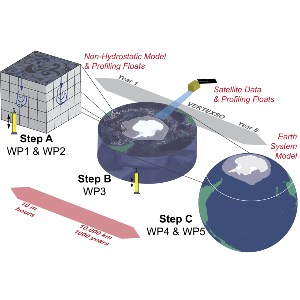VERTEXSO: VERTical EXchange in the Southern Ocean



© VERTEXSO
The Southern Ocean is of major importance for the Earth’s climate system, serving as the gateway for the global ocean’s uptake of roughly 75% of excess heat and 25% of human-induced carbon emissions in the climate. In this capacity, it has significantly slowed the progression of global surface warming. The greatest part of this process has occurred through the renewal of the subsurface waters around Antarctica. However, the same unique physical phenomena that drive this renewal and make the Southern Ocean so important also make it a particular challenge for Earth System Models (ESMs), and they have historically failed to represent the region’s past climactic changes.
The failure of ESMs to reconstruct past climactic changes, like the 2023 sea ice minimum, leads to significant uncertainties in their future projections. The EU-funded VERTEXSO project seeks to close the gap between simulated and observed changes in the Southern Ocean and thus reduce future uncertainties in ESMs’ projections.
VERTEXSO is dedicated to vertical transport processes in both observations and model simulations, with a particular focus on convective plumes. Convection is a regime of fluid flow where surface waters are densified, for example by sea-to-air heat fluxes or sea ice freeze-up processes, before they sink downwards until they achieve neutral buoyancy. The small scales and uniquely swift vertical motion involved make convective plumes difficult to observe and impossible to represent directly in ESMs. The overarching hypothesis of VERTEXSO is that open-ocean convective plumes are important for the vertical exchange of climatically relevant tracers such as heat and carbon, and the inability of ESMs to represent them directly is responsible for large biases in the modelled structure of Southern Ocean water masses.
By means of five Work Packages (WPs), VERTEXSO will: develop a thorough understanding of open-ocean convective plumes in the Southern Ocean, including the associated temporal and spatial scales; improve how they are represented in ESMs; assess their impact on vertical heat and carbon exchange; and develop innovative methods to monitor them.
My goal is to use non-hydrostatic and very high-resolution simulations to develop a mechanistic understanding of convective plumes in the open Southern Ocean. My tool of choice is the MIT general circulation model (MITgcm), which I am running at high-performance computing centres across Germany. By running a suite of simulations of varying resolutions, realism, and domains, I am hoping to identify the spatial and temporal scales of convective plumes, and to assess their role in the vertical exchange of mass and tracers.
Prof. Dr. Alexander Haumann, Principal Investigator
Dr. Krissy Anne Reeve, Postdoc
The goal of Work Package 2 is to develop a body of observational evidence for convective plumes and to estimate the impact of these plumes on the vertical tracer distribution of the Southern Ocean. Due to the harshness and remoteness of the Southern Ocean, the primary tool we use is biogeochemical Argo floats, which are autonomous profiling robots deployed throughout the global ocean. With the addition of the limited ship-collected and mooring data that is available, Work Package 2 will provide the first observation-based assessment of the full spatial and vertical extent of convective plumes in the Southern Ocean.
Work Package 3 is dedicated to deriving novel observational measures of the surface ocean static stability, thereby enabling continuous and large-scale monitoring of possible vertical instabilities. Specifically, using a combination of Argo floats and satellite-based observations, we will develop a new approach to using satellite-based data to identify surface-induced changes to the density stratification. Work Package 3 thereby transforms our ability to observe and detect critical stratification changes over large regions and long period, and we will then be able to target new avenues for observational campaigns.
Work Package 4 implements a representation of convective plumes that occur on scales smaller than the resolved grid scale into an ESM and assesses their impact on Southern Ocean biases and historical climate change. The tool of choice will be the AWI Earth System Model (AWI-ESM), which uses an adaptable horizontal grid to permit mesoscale-resolving simulations in the high-latitude Southern Ocean. The goal of Work Package 4 is to develop a general form of a subgridscale convection parameterisation that is simple enough to be applied by the next Coupled Model Intercomparison Project (CMIP), which informs the Intergovernmental Panel on Climate Change (IPCC) Assessment Reports and thus policy.
Work Package 5 deals with the impact of vertical exchange in the Southern Ocean on global climatic changes. By assessing the impact of Southern Ocean vertical exchange, in particular convective plumes, on global climatic changes and the carbon cycle, we will be able to understand its role in past and future climates. Thus, Work Package 5 addresses one of the most fundamental unanswered questions in the field of climate science: Does carbon dioxide uptake and release in the Southern Ocean increase or decrease in a warming climate?
As part of the SO-CLIM joint research group, VERTEXSO members benefit from affiliation with both the LMU Munich and the Alfred Wegener Institute for Polar and Marine Research (AWI). Our individual projects are detailed below.